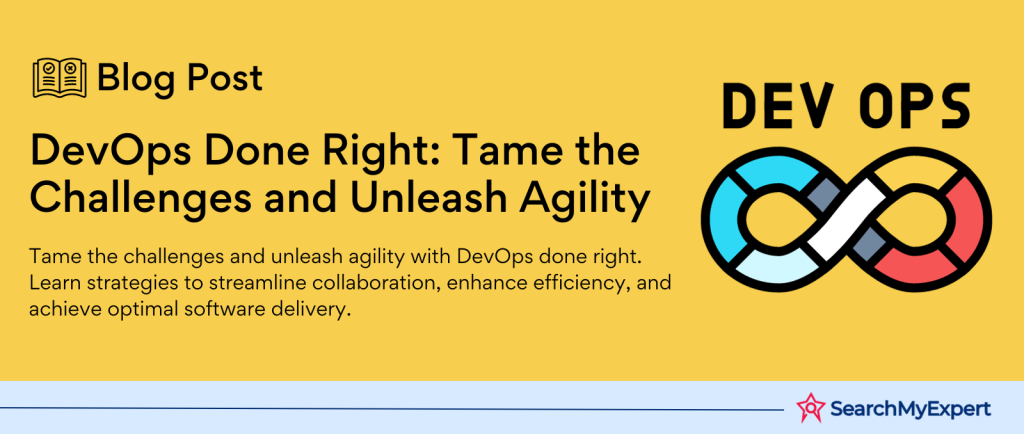Overcoming Common DevOps Challenges
DevOps: Revolutionizing Software Development
DevOps—a blend of ‘Development’ and ‘Operations’—is more than a methodology; it’s a culture shift in the world of software development. At its core, DevOps hinges on collaboration, integration, and communication between software developers and IT operations. This synergy aims to shorten the software development life cycle, providing continuous delivery with high software quality.
The Powerhouse Benefits
- Faster Release Cycles: DevOps accelerates the time to market, thanks to its emphasis on automation, continuous integration, and continuous deployment (CI/CD).
- Enhanced Collaboration:
Breaking down silos, DevOps fosters a culture of shared responsibility, seamless communication, and combined workflows. - Quality and Reliability:
With practices like continuous testing and monitoring, DevOps ensures the reliability and quality of software, reducing the incidence of bugs and outages. - Efficient Problem-solving:
Quick feedback loops and shared perspectives lead to more innovative solutions and efficient problem resolution.
Facing the Challenges Head-On
While the transition to DevOps comes with its trove of benefits, it’s not without challenges. Organizations often grapple with cultural resistance, integration complexities, and the need for new skills and tools. Understanding and addressing these challenges is crucial for a successful DevOps journey.
Silos and Communication Breakdowns
The Barrier of Traditional Silos
In a traditional IT structure, Development (Dev) and Operations (Ops) are distinct entities, often with conflicting goals and priorities. This segregation, known as silos, is a significant hurdle in the path to DevOps success. These silos can lead to:
- Misaligned Objectives: Dev focused on change and innovation, Ops on stability and control.
- Delayed Delivery: Lack of coordination can slow down the development process.
- Quality Compromises:
Limited interaction often results in overlooked defects and operational issues.
Bridging the Gap
The essence of DevOps lies in dismantling these silos. Breaking down these barriers paves the way for a more cohesive, efficient workflow. Key to this transition is fostering cross-functional collaboration. This shift demands:
- Shared Goals:
Aligning objectives of both teams to focus on overall product quality and customer satisfaction. - Increased Visibility:
Encouraging transparency in processes and decisions across both teams. - Integrated Practices:
Merging some roles and responsibilities to facilitate smoother workflow and better understanding.
Communication: The DevOps Lifeline
Effective communication is the cornerstone of DevOps. Here are some strategies to enhance it:
- Regular Meetings: Implementing stand-ups, sprint reviews, or retrospectives to ensure everyone is on the same page.
- Shared Tools and Platforms: Utilizing tools like Slack, JIRA, or Confluence for seamless communication and project tracking.
- Creating an Open Culture:
Encouraging team members to share ideas, feedback, and concerns openly, without the fear of backlash.
By adopting these strategies, organizations can foster a culture of collaboration and innovation, essential for the success of DevOps.
Choosing the Right Tools and Technology
The Critical Role of Tools in DevOps
In the DevOps universe, tools are not just facilitators; they are enablers of efficiency, scalability, and success. The right set of tools can make a profound difference in how teams collaborate, automate, and deliver software. However, with a myriad of options available, selecting tools that align with your specific DevOps needs is crucial.
Categories of DevOps Tools
- Configuration Management:
Tools like Ansible, Puppet, and Chef automate the configuration and management of software and systems, ensuring consistency and compliance. - Continuous Integration/Continuous Delivery (CI/CD): CI/CD tools like Jenkins, CircleCI, and GitLab facilitate automated testing and deployment, enabling faster and more reliable software delivery.
- Monitoring and Logging:
Solutions such as Prometheus, Grafana, and ELK stack provide insights into application performance and system health, crucial for proactive issue resolution.
Tips for Tool Selection
Choosing the right tools requires a balanced approach, considering various factors:
- Assess Team Size and Skills:
Smaller teams might favor tools with simpler interfaces and lower learning curves, while larger organizations might need more robust, scalable solutions. - Consider Budget Constraints: Open-source tools can be cost-effective, but evaluate if the total cost of ownership, including support and maintenance, fits your budget.
- Technical Compatibility and Integration:
Ensure the tools you choose integrate well with your existing ecosystem and support your technical requirements. - Vendor Support and Community:
A strong community and vendor support can be invaluable for troubleshooting and keeping the tools up to date.
By carefully evaluating these aspects, teams can select the right mix of tools to streamline their DevOps practices and drive successful outcomes.
Automation is Key
Streamlining DevOps with Automation
In the DevOps world, automation is not just a luxury; it’s a necessity. By automating repetitive and mundane tasks, teams can focus on more strategic, value-adding activities. Automation brings numerous benefits:
- Increased Efficiency:
Automation speeds up processes, from code development to deployment, reducing cycle times. - Consistency and Reliability:
It minimizes human error, ensuring consistent results every time. - Scalability:
Automated processes can be easily scaled up or down based on demand.
Key Areas for Automation
- Deployments:
Automating deployments ensures that software can be reliably and consistently released at any time. - Testing: Automated testing verifies code changes quickly and thoroughly, ensuring software quality.
- Infrastructure Provisioning:
Automation tools can rapidly set up and manage infrastructure, a practice known as Infrastructure as Code (IaC).
Tools and Techniques for Automation
- Scripting:
Simple automation can be achieved through scripting languages like Bash, Python, or PowerShell. - Infrastructure as Code (IaC): Tools like Terraform and AWS CloudFormation allow you to manage infrastructure using code, making it more reliable and reproducible.
- Containerization: Technologies like Docker and Kubernetes automate the deployment and scaling of applications in containers, leading to more efficient and portable workloads.
Incorporating automation into DevOps is a game-changer, turning potential chaos into orchestrated harmony. The key is to identify repetitive tasks and implement automation systematically.
Embracing a Culture of Learning and Experimentation
The Heart of DevOps: Continuous Learning
In the dynamic landscape of DevOps, resting on laurels isn’t an option. Continuous learning and experimentation are key drivers of innovation and improvement. This culture is pivotal for:
- Keeping Up with Technological Advances:
The tech world evolves rapidly; staying updated is
crucial. - Fostering Innovation:
Experimentation leads to new, more efficient solutions. - Enhancing Team Skills: Continuous learning keeps the team’s skills sharp and relevant.
Encouraging Experimentation
DevOps teams must be encouraged to:
- Try New Tools and Practices: Exploring new methodologies or technologies can uncover more efficient ways of working.
- Share Learnings:
Collective learning grows the team’s knowledge base and fosters a supportive environment. - Learn from Failures:
View failures as learning opportunities, not setbacks.
Building a Learning Culture
Here’s how to create an environment that values learning:
- Provide Training Opportunities:
Regular workshops, courses, and seminars can boost team knowledge. - Promote Open Feedback:
Encourage open discussions about successes and failures alike. - Celebrate Successes and Innovations:
Acknowledge and reward innovative ideas and improvements.
Such a culture not only enhances the team’s capabilities but also contributes to job satisfaction and employee retention.
Measuring and Monitoring Your Progress
The Compass of DevOps: Tracking Performance
In the DevOps journey, measuring and monitoring are akin to a compass guiding a ship. Without these, you’re navigating blind. Tracking progress is crucial for:
- Understanding Current Performance: Know where you stand in terms of efficiency and effectiveness.
- Identifying Improvement Areas:
Spotting bottlenecks and issues becomes easier with concrete data. - Validating Changes and Strategies:
Assess whether changes made are yielding the desired results.
Key Metrics in DevOps
- Lead Time: The time it takes to go from code commit to code successfully running in production. Shorter lead times indicate higher efficiency.
- Deployment Frequency:
How often deployments are made. More frequent deployments can signify a more agile and responsive development process. - Error Rate:
The percentage of deployments causing failure in production. A lower error rate indicates better quality control.
Tools for Insightful Monitoring
- Dashboards:
Tools like Grafana or Kibana can provide a visual overview of various metrics, offering real-time insights. - Log Analysis: Solutions like Splunk or the ELK stack help in analyzing logs for error detection and operational intelligence.
- Performance Monitoring:
Tools like New Relic or Datadog offer deep insights into application performance, helping identify issues before they impact the user experience.
Regularly monitoring these metrics and using the right tools to do so can significantly enhance your DevOps processes, leading to a more streamlined and effective pipeline.
Continuous Improvement and Optimization – Embrace the DevOps Spiral
DevOps is not a destination, it’s a journey. Reaching maturity in a DevOps workflow doesn’t mean you set it and forget it. Instead, think of it as a continuous feedback loop, constantly evolving and optimizing.
Regular Process Review:
- Schedule retrospectives:
Dedicate time regularly (monthly, quarterly) to analyze your DevOps pipeline. Look for bottlenecks, redundancies, and areas for improvement. - Gather feedback:
Involve everyone in the process, from developers to ops to security. Solicit input on pain points and suggestions for optimization. - Measure and quantify: Don’t rely on gut feelings. Use metrics like lead time, deployment frequency, and error rates to understand the impact of changes.
Identify and Tame Bottlenecks:
- Pinpoint pain points:
Are deployments slow? Testing taking too long? Identify your critical bottlenecks that hinder efficiency. - Automate where possible: Automate repetitive tasks to free up human resources for more strategic work. Utilize IaC, containerization, and scripting to streamline workflows.
- Retool and adjust:
Don’t hesitate to change tools and technologies if they aren’t serving your needs. Stay flexible and adapt to the evolving landscape.
Proactive Optimization:
- Embrace experimentation:
Don’t be afraid to try new things. Experiment with different tools, techniques, and methodologies to find what works best for your team. - Stay informed: Keep track of the latest DevOps trends and best practices. Attend conferences, read blogs, and network with other practitioners.
- Share and learn: Foster a culture of knowledge sharing within your team. Encourage individuals to learn from each other’s experiences and best practices.
Tools for Continuous Improvement:
- Use monitoring dashboards:
Visualize your DevOps pipeline performance with real-time dashboards. Identify anomalies and proactively address potential issues. - Leverage feedback platforms: Utilize tools like incident reporting systems and suggestion boards to capture feedback and track progress on improvement initiatives.
- Adopt automation for optimization: Automate tasks like regression testing, infrastructure provisioning, and deployment rollbacks to minimize manual intervention and optimize performance.
Conclusion
DevOps promises faster releases and happier teams, but it’s not a magic trick. Silos, tools, and even automation can slow you down. The secret sauce? Continuous improvement! Regularly review your process, identify roadblocks, and adapt like a chameleon. Experiment, learn from others, and share the knowledge. Tools like dashboards and automation can be your friends. Remember, DevOps is a journey, not a destination. Embrace the bumps, keep learning, and you’ll reach a high-performing, happy DevOps land in no time!
Optimize your development process with our DevOps Company.
Table of Contents
Toggle






